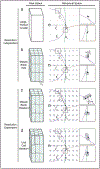3D Nanocrystallography and the Imperfect Molecular Lattice
- PMID: 38941528
- PMCID: PMC11801403
- DOI: 10.1146/annurev-physchem-083122-105226
3D Nanocrystallography and the Imperfect Molecular Lattice
Abstract
Crystallographic analysis relies on the scattering of quanta from arrays of atoms that populate a repeating lattice. While large crystals built of lattices that appear ideal are sought after by crystallographers, imperfections are the norm for molecular crystals. Additionally, advanced X-ray and electron diffraction techniques, used for crystallography, have opened the possibility of interrogating micro- and nanoscale crystals, with edges only millions or even thousands of molecules long. These crystals exist in a size regime that approximates the lower bounds for traditional models of crystal nonuniformity and imperfection. Accordingly, data generated by diffraction from both X-rays and electrons show increased complexity and are more challenging to conventionally model. New approaches in serial crystallography and spatially resolved electron diffraction mapping are changing this paradigm by better accounting for variability within and between crystals. The intersection of these methods presents an opportunity for a more comprehensive understanding of the structure and properties of nanocrystalline materials.
Keywords: 3DED; MicroED; SFX; crystallography; nanocrystal.
Figures









References
-
- Aroyo MI, ed. 2016. International Tables for Crystallography: Space-Group Symmetry, Vol. Chester A, UK: Int. Union Crystallogr. 2nd ed.
-
- Karamertzanis PG, Pantelides CC. 2007. Ab initio crystal structure prediction. II. Flexible molecules. Mol. Phys 105(2–3):273–91
-
- Bragg WL. 1970. Early days. Acta Crystallogr. A 26(2):171–72
Publication types
Grants and funding
LinkOut - more resources
Full Text Sources

